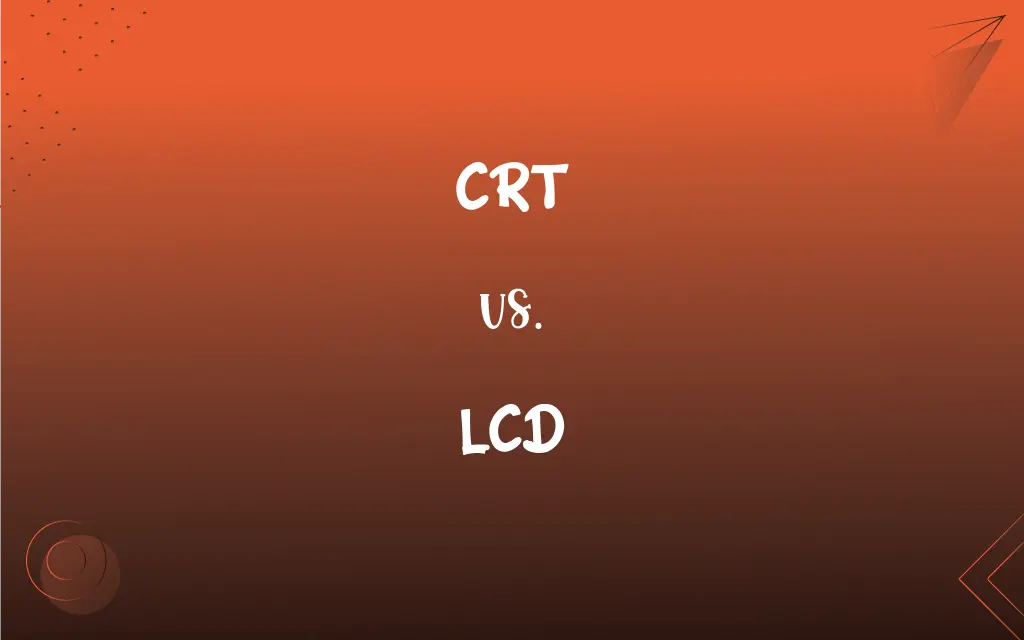CRT vs. LCD: What's the Difference?
Edited by Aimie Carlson || By Janet White || Published on February 13, 2024
CRT (Cathode Ray Tube) uses electron beams to illuminate phosphors; LCD (Liquid Crystal Display) uses liquid crystals and backlighting for image display.

Key Differences
CRT, or Cathode Ray Tube, technology involves firing electron beams at a phosphor-coated screen to produce images. In contrast, LCD, or Liquid Crystal Display, creates images using liquid crystals that align to block or pass light from a backlight.
CRT displays are known for their deep blacks and wide viewing angles but suffer from bulkiness and high energy consumption. LCDs offer a thinner, more energy-efficient alternative, although they can struggle with true black representation and viewing angle consistency.
The weight and size of CRTs are significant due to the vacuum tube technology and large glass screens. LCDs, utilizing thin layers of liquid crystals and light-emitting diodes or fluorescent backlights, are much lighter and slimmer.
In terms of image quality, CRTs excel in color accuracy and response time, making them popular for certain professional applications. LCDs, however, provide higher native resolutions and do not suffer from geometric distortion or flickering issues common in CRTs.
CRT technology is largely obsolete now, replaced by LCD and other modern display technologies in most applications due to their compact size, lower power consumption, and evolving image quality.
ADVERTISEMENT
Comparison Chart
Technology
Electron beams illuminate phosphors
Liquid crystals align to control light passage
Size and Weight
Bulky and heavy due to vacuum tube
Slim and lightweight
Energy Efficiency
Higher power consumption
More energy-efficient
Image Quality
Excellent color accuracy, prone to flickering
Higher resolution, potential limited viewing angles
Modern Usage
Largely obsolete
Widely used in various devices
ADVERTISEMENT
CRT and LCD Definitions
CRT
CRTs have high color accuracy and quick response times.
The CRT monitor displayed vibrant and accurate colors.
LCD
LCD uses liquid crystals and backlighting for image display.
My laptop's screen is a high-resolution LCD.
CRT
CRT displays are characterized by deep blacks and wide angles.
Gamers often prefer CRT monitors for their fast response time.
LCD
LCD screens are known for their slim design and efficiency.
The lightweight LCD TV was easy to mount on the wall.
CRT
CRT is a technology using electron beams to create images.
The old television set used CRT technology for display.
LCD
LCDs offer higher resolutions and consume less power.
The new LCD monitor is much more energy-efficient.
CRT
A CRT screen is bulky due to its vacuum tube construction.
Moving the CRT TV was difficult due to its weight.
LCD
LCD technology struggles with true black levels and angles.
The LCD screen looked washed out from the side.
CRT
CRT technology is now largely replaced by modern displays.
CRTs were common before the advent of flat-screen TVs.
LCD
LCDs are the standard in modern display technology.
Most smartphones use advanced LCD or OLED screens.
CRT
A cathode-ray tube.
LCD
A digital display that uses liquid crystal cells that change reflectivity in an applied electric field; used for portable computer displays and watches etc.
CRT
A monitor, television, or projector that displays an image using a cathode-ray tube.
CRT
A vacuum tube in which a hot cathode emits a beam of electrons that pass through a high voltage anode and are focused or deflected before hitting a phosphorescent screen
FAQs
How does a CRT display images?
By using electron beams to illuminate phosphors.
What does CRT stand for?
Cathode Ray Tube.
What are the advantages of LCDs over CRTs?
Slimmer design, lower power consumption, and higher resolution.
Do LCDs have better resolution than CRTs?
Generally, yes, LCDs offer higher native resolutions.
Are CRT displays still common?
No, they are largely obsolete.
Do LCDs consume less energy than CRTs?
Yes, LCDs are more energy-efficient.
What does LCD stand for?
Liquid Crystal Display.
Are CRTs heavier than LCDs?
Yes, CRTs are much heavier and bulkier.
How does an LCD display images?
Through liquid crystals that control light passage from a backlight.
Do CRTs have flickering issues?
Yes, they can have flickering and geometric distortion.
Can LCDs display high-definition content?
Yes, they are capable of high-definition display.
Are LCDs suitable for professional graphic work?
Yes, especially high-end models with good color fidelity.
Can CRTs display true black better than LCDs?
Yes, CRTs are known for better black level representation.
Do CRTs have a wider viewing angle than LCDs?
Yes, CRTs generally have wider viewing angles.
Is the response time of a CRT better than an LCD?
Yes, CRTs typically have faster response times.
Why are CRTs not preferred anymore?
Due to their size, weight, and energy consumption.
Has LCD technology evolved over the years?
Yes, with improvements in color, resolution, and response time.
Can LCDs be used for gaming?
Yes, especially modern LCDs with faster response times.
Are LCDs better for wall mounting?
Yes, due to their slim and lightweight design.
Is color accuracy better in CRTs or LCDs?
CRTs typically have better color accuracy.
About Author
Written by
Janet WhiteJanet White has been an esteemed writer and blogger for Difference Wiki. Holding a Master's degree in Science and Medical Journalism from the prestigious Boston University, she has consistently demonstrated her expertise and passion for her field. When she's not immersed in her work, Janet relishes her time exercising, delving into a good book, and cherishing moments with friends and family.
Edited by
Aimie CarlsonAimie Carlson, holding a master's degree in English literature, is a fervent English language enthusiast. She lends her writing talents to Difference Wiki, a prominent website that specializes in comparisons, offering readers insightful analyses that both captivate and inform.






































































